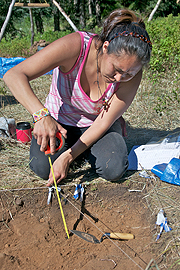UNBC Students Take Part in Babine Lake Region Excavation
By 250 News
Tuesday, July 27, 2010 03:45 AM
 Prince George, B.C. - This summer the UNBC Anthropology Program and the Lake Babine Nation are hosting an archaeology field school at Babine Lake, which includes the first-ever excavation in the area. Fourteen students are enrolled in the program, which involves hands-on training in archaeological field methods. The students come from UNBC and other post-secondary institutions as well as the Lake Babine Nation. They began work on the site, roughly 100 kilometres north-east of Smithers, in June. ( at right, Lake Babine Nation student Ramona Williams prepares to take measurements during excavation)
Prince George, B.C. - This summer the UNBC Anthropology Program and the Lake Babine Nation are hosting an archaeology field school at Babine Lake, which includes the first-ever excavation in the area. Fourteen students are enrolled in the program, which involves hands-on training in archaeological field methods. The students come from UNBC and other post-secondary institutions as well as the Lake Babine Nation. They began work on the site, roughly 100 kilometres north-east of Smithers, in June. ( at right, Lake Babine Nation student Ramona Williams prepares to take measurements during excavation)A major part of the project involves excavating an ancient village at Nilkitkwa Lake, just north of Babine Lake. “There are literally hundreds of underground cache pits and earth ovens within the village,” says UNBC Anthropology professor Farid Rahemtulla, who is directing the project. “This is one of the most amazing archaeological sites in the north-central interior.”
The group is focusing on a part of the village where community members processed and stored various foods such as salmon. Students from UNBC are working side by side with members of the Babine community and all participants are receiving academic credit for their work. “Being involved in this dig makes me feel a deep connection to my ancestors,” says Mathew Adam of the Babine Nation. “I feel I have a better understanding of my culture.”
So far the group has uncovered a variety of stone tools that were used to prepare and process the foods that were stored in cache pits over the winter. Samples have been collected from the site, and will soon be sent to a radiocarbon lab for dating.
The training also has the potential to enable participants to gain employment as archaeological consultants or researchers. “It’s such an amazing opportunity for us to be involved in an archaeological research project in northern B.C,” says UNBC Anthropology student Keith Hansen. “This is a great start to my career.”
The group began excavations in early July and will continue digging until the end of the month. Over the next few years the Lake Babine Nation and the Anthropology Program plan to continue to work at the site, where the focus will be to excavate the remains of longhouses that once existed at the village.
Previous Story - Next Story
Return to Home










I had a bit of a taste of their traditional culture, it is very much of the earth, wind, fire and water. It touches the natural elements and we are only a custodian to the creator. Its based on, don't take no more than you need, and leave the rest so that it can replenish itself.